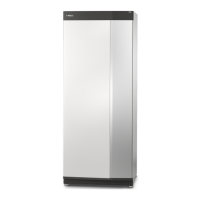Room sensor
S1156 is supplied with an enclosed room sensor (BT50) that
makes it possible to display and control the room temperat-
ure in the display on S1156.
Fit the room sensor in a neutral position where a set temper-
ature is required. A suitable location might be, for example,
on a free inner wall in a hall approx. 1.5 m above the floor. It
is important that the room sensor is not obstructed from
measuring the correct room temperature, for example by
being located in a recess, between shelves, behind a curtain,
above or close to a heat source, in a draught from an external
door or in direct sunlight. Closed radiator thermostats can
also cause problems.
S1156 operates without room sensor, but if you want to read
the home’s indoor temperature from the display on S1156,
the room sensor must be fitted. Connect the room sensor
to terminal block X28:13 and AA2-X29:GND.
If a room sensor is to be used to change the room temperat-
ure in °C and/or to fine-tune the room temperature, the
sensor must be activated in menu 1.3 - "Room sensor set-
tings".
If a room sensor is used in a room with underfloor heating,
it should only have an indicatory function, not control of the
room temperature.
13
12
11
10
14
BT50
BT25
BT6
AUX8
BT1
BT50
AA2-X28
AA2-X29
Caution
Changes of temperature in accommodation take
time. For example, short time periods in combina-
tion with underfloor heating will not give a notice-
able difference in room temperature.
Pulse energy meter
Up to two electricity meters or energy meters for heating
(BE6, BE7) can be connected to S1156 via terminal blocks
AA2-X28:1-2 and AA2-X30:7-8.
0-5V
+5V
AUX 1
AUX 2
OT+
0-5V
+5V
GND
AA2-X30
AA2-X28
1
4
3
2
BE6
BE7
6
9
8
7
+5V
+5V
Activate the meter(s) in menu 7.2 - "Accessory settings"
and then set the desired value ("Energy per pulse" or "Pulses
per kWh") in menu 7.2.19 -"Pulse energy meter".
Load monitor
Integrated load monitor
S1156 is equipped with a simple form of integrated load
monitor, which limits the power steps for the electric addi-
tional heat by calculating whether future power steps can
be connected to the relevant phase without exceeding the
current for the specified main fuse.
If the current would exceed the specified main fuse, the
power step is not permitted. The size of the property’s main
fuse is specified in menu 7.1.9 - "Load monitor".
COMMUNICATION
Multi-installation
Several heat pumps can be interconnected by selecting one
heat pump as the main unit and the others as subordinate
heat pumps.
Ground source heat pumps with multi-installation function-
ality from NIBE can be connected to S1156.
A further eight heat pumps can be connected to the main
unit. In systems with several heat pumps, each pump must
have a unique name. Only one heat pump can be "Main unit"
and only one can be, for example, "Heat pump 5". Main
unit/heat pump are set in menu 7.3.1.
External temperature sensors and control signals must only
be connected to the main unit, except for external control
of the compressor module.
NOTE
When several heat pumps are connected together,
an external supply temperature sensor (BT25) and
an external return line sensor (BT71) must be used.
Connect the communication cables between the heat pumps
in series to terminal block X30:1 (GND), X30:2 (+12V), X30:3
(B) and X30:4 (A) on the base board (AA2).
The example shows the connection of several S1156 .
Huvudenhet Värmepump 2 Värmepump 3
2 3 41
B
A
GND
+12V
AA2-X30 AA2-X30 AA2-X30
2 3 41
B
A
GND
+12V
2 3 41
B
A
GND
+12V
Main unit
Heat pump 2 Heat pump 3
Connecting accessories
Instructions for connecting accessories are provided in the
manual accompanying the accessory. See section "Accessor-
ies" for a list of the accessories that can be used with S1156.
Connection for communication with the most common ac-
cessories is shown here.
Accessories with accessory board (AA5)
Accessories with accessory board (AA5) connect to terminal
block AA2-X30:1, 3, 4 in S1156.
25Chapter 5 | Electrical connectionsNIBE S1156

